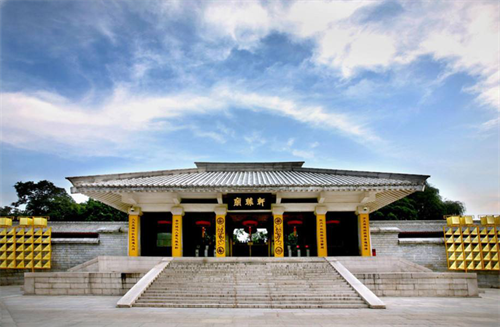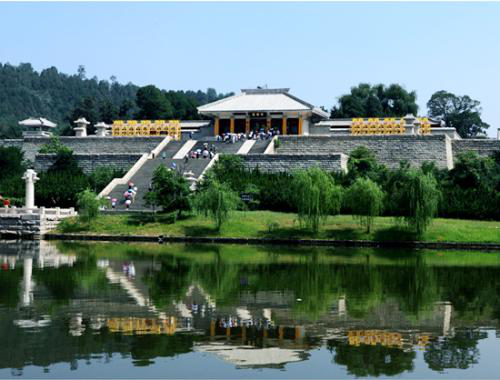The Mausoleum of Huangdi (Yellow Emperor)

Huangdi Mausoleum, namely the memorial mausoleum of legendary Huangdi, is the most important ancient grave site in China. After many years' development and construction, it became not only a mausoleum, but a key point of interest for historical Chinese culture. The main sights in this scenic spot are Huangdi Mausoleum and Xuanyuan Temple. Before visiting this location, one should know about Huangdi in detail.
Huangdi, namely the Yellow Emperor the initiator of Chinese civilization, was a great tribal leader in the final primitive society of ancient times. His family name was Gongsun. Because he grew up at Xuanyuan hill (in Xinzheng County of Henan Province), he was called Xuanyuan. He worshipped the virtue of the yellow earth (the source of food and clothes); hence people call him Huangdi. It is said that 5000 years ago, he cooperated with Yandi to defeat the Chiyou tribe, then unified the other tribes and established the Hua Xia nationality (the former name of the Chinese Nation). He was able to make weapons, vessels and vehicles, and to raise silkworms. He and his contemporaries created the characters, instruments, medicines and counting systems etc, which ended the savage and wild period.

Huangdi is remembered in history for punishing evils and for the first unification of the Chinese Nation. It is said that he lived for 118 years. Once during his tour in Henan Province, a yellow dragon fell down from the heaven after a thunderbolt. The dragon said to him: ‘Your task is finished. You should follow me to heaven.’ Huangdi knew he could not disobey destiny so he rode on the dragon. As they flew over Mt. Qiao, Huangdi asked to be allowed to go down to comfort his country. People cried out and came here; they pulled on his clothes to try to keep him on earth, but it was in vain. He only left his clothes. Afterward, people buried Huangdi’s clothes here and established the mausoleum. Some writings claim Huangdi himself was buried here.
Xuanyuan Temple

Xuanyuan Temple is also named Huangdi Temple, established in the Ming Dynasty (1368 --- 1644). The main structures inside the temple are Temple Gate, Chengxin Kiosk, Stele Pavilion and ‘Renwen Chuzu’ (Huangdi, the initiator of Chinese civilization) Hall. Inside the grand ‘Renwen Chuzu’ Hall, Huangdi’s seat of spirit tablet (an exquisite piece of wood with his name on it) is worshipped. People can do obeisance or hold ceremonies in front of it. Among 14 cypresses in the courtyard, the must-see ones are two: the cypress planted by Huangdi and the Jiangjun (general) cypress.
It is said that Huangdi planted the cypress thousands of years ago to encourage planting of trees and forestation. Now the huge green umbrella is 19 meters high (about 20.8 yards) and is the oldest cypress in the world. There is another legend about the Jiangjun cypress that says Emperor Wu of Han Dynasty ever hung his visor on the pine, so people call it Jiangjun cypress. It is also a rare type of cypress. Situated in the west portion of Xuanyuan Temple is the Gongde (merits and virtues) Altar, the theme of which is the outstanding achievements of Huangdi. Gongde Altar is a round platform with three concentric cylindrical walls on which embossed characters describe Huangdi and his country’s contribution to human progress. The altar is surrounded by 33 stone steles (representing 33 provinces of the country) called China Tongxin (meaning ‘with one heart’) Stone Steles, symbolizing the solidarity of the Chinese Nation.
Huangdi made great contributions to Chinese civilization and the role of China among the four ancient civilized countries in the world. Today, Huangdi Mausoleum, the center of magnificent cultural activity in China, is the symbol of Chinese civilization and the ‘root’ of the Chinese Nation. For thousands of years, every Tomb-Sweeping Day swarms of people have come here to hold a memorial ceremony to him.
In 2006, the public memorial service of the Yellow Emperor (the sacrificial ceremony of the Mausoleum of Yellow Emperor) was included in the first batch of the National Level Intangible Cultural Heritage List. A large number of overseas compatriots came to ancestor worship there each Qingming Festival.
TIPS
1. Basic info
Address: Huangling County, City of Yan’an, Shaanxi
Ticket:
Peak season (March 1st ~ November 30th): 90 CNY;
Low season (December 1st to February 28th): 50 CNY.
Children under 1.4 meters in height are free of charge, children over 1.4 meters in height, children's tickets, and student tickets are 50 CNY;
Free tickets for seniors over 70 years old, 50 CNY per person for people over 65-70 years old;
Opening time: 7:30-18:30
2. Transportation
Bus from Xi'an Nanguan Bus Station or Xi'an Chengdong Bus Station to Huangling County;
Coach from the Bus Station in south Xi'an Railway Station directly to Huangdi Mausoleum.
3. Official Website


